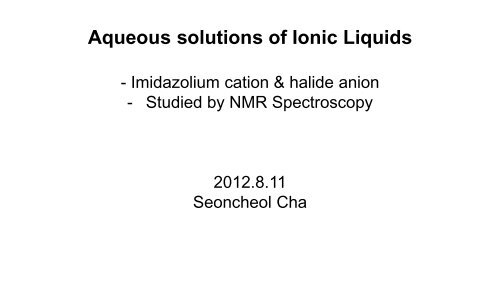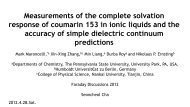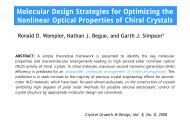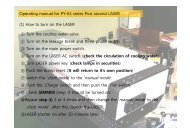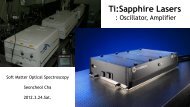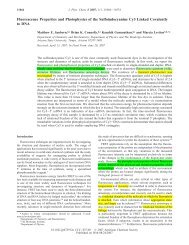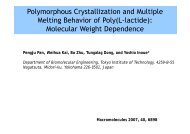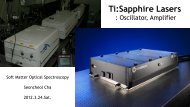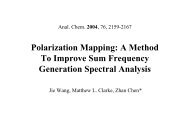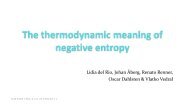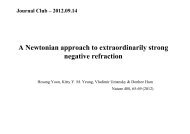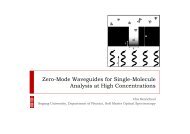Aqueous solutions of Ionic Liquids
Aqueous solutions of Ionic Liquids
Aqueous solutions of Ionic Liquids
Create successful ePaper yourself
Turn your PDF publications into a flip-book with our unique Google optimized e-Paper software.
<strong>Aqueous</strong> <strong>solutions</strong> <strong>of</strong> <strong>Ionic</strong> <strong>Liquids</strong><br />
- Imidazolium cation & halide anion<br />
- Studied by NMR Spectroscopy<br />
2012.8.11<br />
Seoncheol Cha
What is ionic liquids?<br />
Materials exist at liquid state at room-temperature even though having ionic bonding<br />
Low vapor pressure<br />
Low combustibility<br />
Excellent thermal stability<br />
Wide liquid region<br />
Good solvent for<br />
polar/non-polar compounds<br />
Green solvent for alternating organic solvent<br />
Special solvent to synthesis unique chemical<br />
Recycling material<br />
Solar thermal energy transfer/storage medium<br />
Battery electrolyte
[bmim][X] ionic liquid (X : Cl, Br, I)<br />
1-Butyl-3-methylimidazolium<br />
chloride<br />
1-Butyl-3-methylimidazolium<br />
bromide<br />
1-Butyl-3-methylimidazolium<br />
iodide
NMR Spectroscopy<br />
Lecutre Note<br />
Pr<strong>of</strong>. Lee in Chemistry
Chemical Shift<br />
Lecutre Note<br />
Pr<strong>of</strong>. Lee in Chemistry
Upfield, Downfield<br />
Lecutre Note<br />
Pr<strong>of</strong>. Lee in Chemistry
Context<br />
2003 The structure <strong>of</strong> a Room-Temperature <strong>Ionic</strong> Liquid with and without trace amount <strong>of</strong> water :<br />
The role <strong>of</strong> C-H…O and C-H…F Interactions in [C nmim[BF 4]<br />
- NOE / ROE NMR Spectroscopy for [C nmim][BF 4]<br />
- type <strong>of</strong> water-cation interaction / site <strong>of</strong> interaction<br />
Andrea Mele, Chieu D. Tran, Silvia H. De Paoli Lacerda<br />
Angew. Chem. Int. Ed (2003) 42 4364<br />
2008 Aggregation <strong>of</strong> <strong>Ionic</strong> <strong>Liquids</strong> [C nmim]Br (n=4,6,8,10,12) in D 2O : A NMR Study<br />
- 1H NMR, 1H-1H ROESY NMR<br />
- aggregation in aqueous solution <strong>of</strong> ionic liquid<br />
Yang Zhao, Shanjiao Gao, Janji Whang, Junming Tang<br />
J.Phys.Chem.B (2008) 112 2031
2008 Aggregation <strong>of</strong> <strong>Ionic</strong> <strong>Liquids</strong> [Cnmim]Br (n=4,6,8,10,12) in D2O : A NMR Study<br />
d obsd = d obsd – d obsd, m<br />
d obsd, m = observed chemical shift <strong>of</strong> a given IL at the<br />
lowest concentration
2008 Aggregation <strong>of</strong> <strong>Ionic</strong> <strong>Liquids</strong> [Cnmim]Br (n=4,6,8,10,12) in D2O : A NMR Study<br />
CAC (critical aggregation concentration)<br />
Fast exchange <strong>of</strong> monomer and aggregate<br />
assumption ( faster than NMR time scale)<br />
d obsd = d monm mon/m tot + d micm mic/m tot
2008 Aggregation <strong>of</strong> <strong>Ionic</strong> <strong>Liquids</strong> [Cnmim]Br (n=4,6,8,10,12) in D2O : A NMR Study<br />
CAC (critical aggregation concentration)<br />
Fast exchange <strong>of</strong> monomer and aggregate<br />
assumption ( faster than NMR time scale)<br />
d obsd = d monm mon/m tot + d micm mic/m tot<br />
Material Property<br />
Characteristic time t<br />
Response time < t<br />
Response time > t
2008 Aggregation <strong>of</strong> <strong>Ionic</strong> <strong>Liquids</strong> [Cnmim]Br (n=4,6,8,10,12) in D2O : A NMR Study<br />
CAC (critical aggregation concentration)<br />
Fast exchange <strong>of</strong> monomer and aggregate<br />
assumption ( faster than NMR time scale)<br />
d obsd = d monm mon/m tot + d micm mic/m tot<br />
No aggregation assumption below CAC<br />
d obsd = d mic – CAC(d mic-d mon)/m tot
2008 Aggregation <strong>of</strong> <strong>Ionic</strong> <strong>Liquids</strong> [Cnmim]Br (n=4,6,8,10,12) in D2O : A NMR Study<br />
No aggregate for<br />
short chain<br />
Difference<br />
between H 2O and<br />
D 2O (??)<br />
IL CAC1<br />
( mol / kg )<br />
CAC1<br />
d obsd = d monm mon/m tot + d micm mic/m tot<br />
CAC2<br />
d obsd = d mic – CAC(d mic-d mon)/m tot<br />
CAC2<br />
( mol / kg )<br />
Surface<br />
tenstion<br />
( mol/ L )<br />
Ref1<br />
Ref1 : Goodchild et al (2007)<br />
Ref2 : Wang et al (2007)<br />
Electric<br />
conductivity<br />
( mol / L )<br />
ref1<br />
Electric<br />
conductivity<br />
( mol / L )<br />
ref2<br />
[C 4mim][Br] - 2.579 0.8±0.1 0.7±0.3 0.97<br />
[C 6mim][Br] 0.732 0.849 0.6±0.2 0.4±0.3 0.77<br />
[C 8mim][Br] 0.142 0.140 0.15±0.05 0.15±0.06 0.16<br />
[C 10mim][Br] 0.030 0.032 0.04±0.02 0.03±0.01 0.039<br />
[C 12mim][Br] 0.011 0.011 0.009
[BMIM][Br] Rosey<br />
below CAC above CAC<br />
Many cross-peaks appear<br />
H2-H1,H3 | H5-H4,H6 : intermolecular interaction<br />
H12/H1-H5 : ring-alkyl chain contact (intramolecular)
[BMIM][Br] Rosey<br />
above CAC<br />
Many cross-peaks appear<br />
H2-H1,H3 | H5-H4,H6 : intermolecular interaction<br />
H12/H1-H5 : ring-alkyl chain contact (intramolecular)


